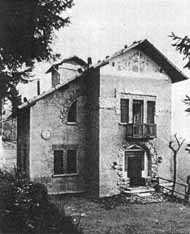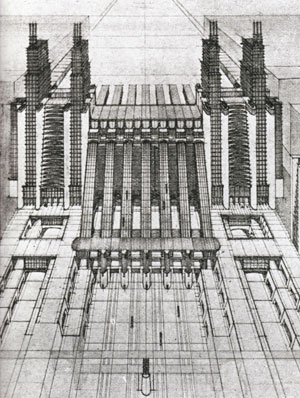“We shall sing of the
great crowds galvanised by labour, pleasure or
unrest;
Of the many-coloured and
polyphonic tides of revolution in the modern
capitals;
We shall sing of the
vibrating nocturnal fervour of the arsenals and the building yards
ablaze with violent electric
moons;
Of swollen railway
stations, avid for smoking
serpents;
Of factories hung from
the clouds by means of the twisted arabesques of their
smoke;
Of bridges bestriding
rivers like giant
gymnasts…
Of bold steamboats
scouting the horizons, of broad-chested locomotives pawing the
tracks like huge steel horses bridled with pipes, and the guiding
flight of aeroplanes”
Italian architect Antonio
Sant’Elia (1888-1916) from his essay
‘Messagio’
Sant’Elia was a modernist
architect. He believed in the future. He believed it would be big,
bright, shiny and that it would work. To again get carried away in
the moment, his 1914 Manifesto
proclaimed:
“We must invent and
rebuild the Futurist city like an immense and tumultuous shipyard,
agile, mobile and dynamic in every detail; and the Futurist house
must be like a gigantic machine. The lifts must no longer be hidden
away like tapeworms in the niches of stairwells; the stairwells
themselves, rendered useless, must be abolished, and the lifts must
scale the lengths of the façade like serpents of steel and glass.
The house of concrete, glass and steel, stripped of paintings and
sculpture, rich only in the innate beauty of its lines and relief,
extraordinarily ugly in its mechanical simplicity, higher and wider
according to need rather than the specifications of municipal laws.
It must soar up on the brink of a tumultuous abyss: the street will
no longer be like a doormat at ground level, but will plunge many
floors down into the earth, embracing the metropolitan traffic, and
will be linked up by metal gangways and swift-moving pavements for
necessary interconnections.”

Mighty stuff for
1914. Sant’Elia was 26
years old at the time.
It proved heady inspiration for Renzo Piano and Richard
Rogers as well as many of their predecessors. Sant’Elia envisioned
his Città Nuova in 1913 and 1914. By this time he had only actually
built one project - a hunting lodge called the Villa Elisi.
The Villa Elisi is I'm sure very nice to stay in. It looks a
little like a smaller version of the house in the 'Amityville
Horror'. Radical it is not. It would look equally at home as a
Russian dacha, a cottage in Mullingar or a suburban
dwelling in Queens NY.

Yet radical was exactly
what Sant'Elia came up with next. He designed a
new Modernist city, the Città
Nuova. A stunning vertically-oriented glass and steel
paradise. Central to the scheme was a transport interchange -
a massive multi-level railway station feeding directly into
a massive office
building. In true heroic Modernist style there are jutting
bridges and soaring towers. As you can see from the
illustration at left, it doesn't look unlike the design of the
Canary Wharf tube station in London. Given that the architect
was a mere 26 years old at the time, this was a tremendous
achievement.
Stunningly for 1914, the transport interchange is
backed by an airport stretching into the distance beyond. Even
more presciently, the airport is unbounded - it isn't hemmed in by
other aspects of the development and has room to expand as the needs
of the city change over time. It's a proven fact of life that
airports evolve and mutate, something that is often forgotten by
well-intentioned architects.

